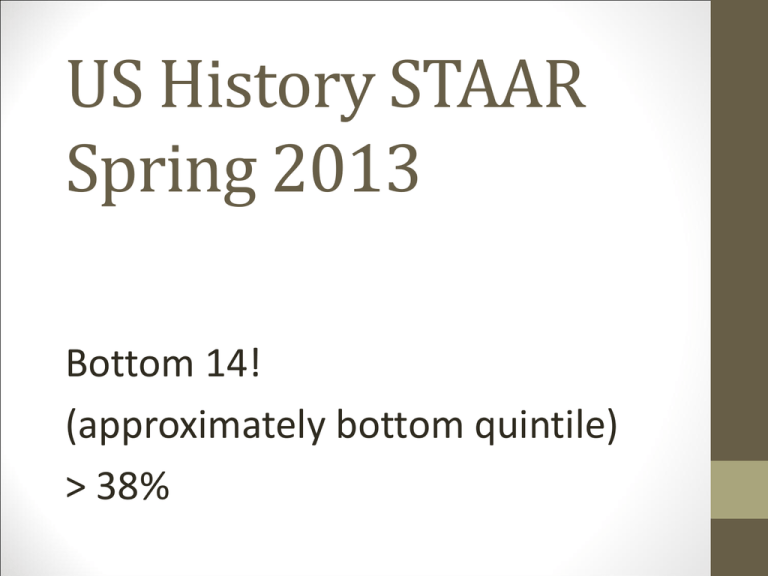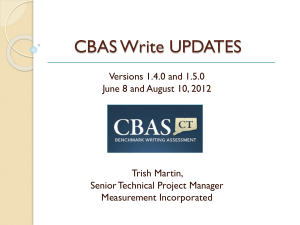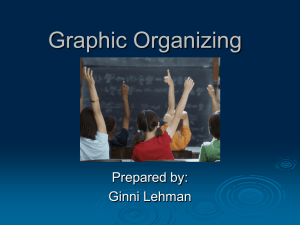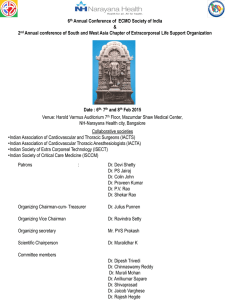Grade 8 and US History STAAR
advertisement

US History STAAR Spring 2013 Bottom 14! (approximately bottom quintile) > 38% US History: STAAR Scores • Level III = 7 • Level II = 73 • Level I = 27 • 7903 Students Assessed Format of Questions • Dual-Coded = 34 (50%) • Images = 11 • Graphs (data) = 3 • Graphic Organizers = 6 • Quotes/Excerpts = 14 • Maps = 2 RC 4, SS H.28(B): explain how space technology and exploration improve the quality of life H.29(H) A = 17 B = 27 C = 30 D = 26* RC 1, RS H.7(G): explain the home front and how American patriotism inspired exceptional actions by citizens and military personnel, including high levels of military enlistment; volunteerism; the purchase of war bonds; Victory Gardens; the bravery and contributions of the Tuskegee Airmen, the Flying Tigers, and the Navajo Code Talkers; and opportunities and obstacles for women and ethnic minorities F = 29 G = 33 H = 30* J= 8 RC 1, RS H.9(F): describe presidential actions and congressional votes to address minority rights in the United States, including desegregation of the armed forces, the Civil Rights acts of 1957 and 1964, and the Voting Rights Act of 1965 F = 40 G = 31* H = 10 J = 19 RC 3, RS H.23(A): identify and analyze methods of expanding the right to participate in the democratic process, including lobbying, non-violent protesting, litigation, and amendments to the U.S. Constitution; H.30(B) F = 39 G = 16 H = 31* J = 14 RC 2, SS H.26(D): identify the political, social, and economic contributions of women such as Frances Willard, Jane Addams, Eleanor Roosevelt, Dolores Huerta, Sonia Sotomayor, and Oprah Winfrey to American society F = 47 G=8 H = 31* J = 14 RC 2, SS H.26(E): discuss the meaning and historical significance of the mottos "E Pluribus Unum" and "In God We Trust" F = 25 G = 33* H = 16 J = 26 RC 1, RS H.3(C): analyze social issues affecting women, minorities, children, immigrants, urbanization, the Social Gospel, and philanthropy of industrialists H.29(H) F = 23 G = 12 H = 31 J = 34* RC 1, SS H.7(E): analyze major military events of World War II, including the Battle of Midway, the U.S. military advancement through the Pacific Islands, the Bataan Death March, the invasion of Normandy, fighting the war on multiple fronts, and the liberation of concentration camps H.29(H) F = 37 G = 21 H=8 J = 35* RC 2, SS H.25(A): describe how the characteristics and issues in U.S. history have been reflected in various genres of art, music, film, and literature H.29(B) A = 32 B = 19 C = 35* D = 14 RC 1, SS H.6(B): analyze the impact of significant individuals such as Clarence Darrow, William Jennings Bryan, Henry Ford, Glenn Curtiss, Marcus Garvey, and Charles A. Lindbergh F = 13 G = 26 H = 26 J = 35* RC1, RS H.4(A): explain why significant events, policies, and individuals such as the Spanish-American War, U.S. expansionism, Henry Cabot Lodge, Alfred Thayer Mahan, Theodore Roosevelt, Sanford B. Dole, and missionaries moved the United States into the position of a world power H.29(B) A = 19 B= 37* C = 23 D = 21 RC 2, RS H.13(B): analyze the causes and effects of changing demographic patterns resulting from legal and illegal immigration to the United States H.29(H) F = 12 G = 38* H = 26 J = 24 RC 4, RS H.17(B): identify the causes of prosperity in the 1950s, including the Baby Boom and the impact of the GI Bill (Servicemen's Readjustment Act of 1944), and the effects of prosperity in the 1950s such as increased consumption and the growth of agriculture and business F = 38* G = 20 H = 19 J = 23 RC 1, RS H.5(A): evaluate the impact of Progressive Era reforms, including initiative, referendum, recall, and the passage of the 16th, 17th, 18th, and 19th amendments H.29(B) A = 25 B = 18 C = 38* D = 19 RC1, RS H.10(D): describe U.S. involvement in the Middle East such as support for Israel, the Camp David Accords, the IranContra Affair, Marines in Lebanon, and the Iran Hostage Crisis F = 18 G = 19 H = 24 J = 38* Analysis of Bottom 14 • Dual Coded: 8 out of 14 (57%) • Images: 3 out of 14 (21%) • Graphs (data): 1 out of 14 (7%) • Graphic Organizers: 1 out of 14 (7%) • Quotes/Excerpts: 4 out of 14 (29%) • Maps: 0 Grade 8 Social Studies Test Bottom 14 >50 Dual-coded Images = 22 =2 Graphs (data) = 0 Graphic Organizers = 12 Quotes = 8 Maps = 1 Level I (Unsatisfactory) = 37 Level II (Satisfactory) = 63 Level III (Advanced) = 13 344,283 Students Assessed Phase-In 2 Recommended = 44% = 26% RC 1, SS 8.1(C) explain the significance of the following dates: 1607, founding of Jamestown; 1620, arrival of the Pilgrims and signing of the Mayflower Compact; 1776, adoption of the Declaration of Independence; 1787, writing of the U.S. Constitution; 1803, Louisiana Purchase; and 1861-1865, Civil War F = 15 G = 30 H = 25 J = 30* RC4, RS 8.27(B) analyze the impact of transportation and communication systems on the growth, development, and urbanization of the United States F = 22 G = 14 H = 31* J = 32 RC 3, SS 8.22(B) describe the contributions of significant political, social, and military leaders of the United States such as Frederick Douglass, John Paul Jones, James Monroe, Stonewall Jackson, Susan B. Anthony, and Elizabeth Cady Stanton A = 16 B = 32 C = 16 D = 36* RC3, RS 8.16(B) describe the impact of 19thcentury amendments, including the 13th, 14th, and 15th amendments, on life in the United States A = 31 B = 29 C=4 D = 36* RC 3, RS 8.15(D) analyze how the U.S. Constitution reflects the principles of limited government, republicanism, checks and balances, federalism, separation of powers, popular sovereignty, and individual rights 8.30(A) F = 10 G = 38* H = 45 J =7 RC4, SS 8.28(B) identify examples of how industrialization changed life in the United States A=8 B = 17 C = 40* D = 35 RC2, SS 8.23(C) identify ways conflicts between people from various racial, ethnic, and religious groups were resolved 8.29(C) F = 40* G = 19 H = 21 J = 21 RC1, RS 8.4(A) analyze causes of the American Revolution, including the Proclamation of 1763, the Intolerable Acts, the Stamp Act, mercantilism, lack of representation in Parliament, and British economic policies following the French and Indian War F = 18 G = 10 H = 41* J = 31 RC 1, RS 8.7(C) analyze the impact of slavery on different sections of the United States F = 44* G = 33 H = 10 J = 13 RC 2, RS 8.23(A) identify selected racial, ethnic, and religious groups that settled in the United States and explain their reasons for immigration A = 12 B = 44* C = 32 D = 12 RC 3, RS 8.18(A) identify the origin of judicial review and analyze examples of congressional and presidential responses A = 13 B = 45* C = 26 D = 15 RC1, RS 8.5(A) describe major domestic problems faced by the leaders of the new republic such as maintaining national security, building a military, creating a stable economic system, setting up the court system, and defining the authority of the central government F = 14 G = 46* H = 10 J = 30 RC 3, SS 8.18(B) summarize the issues, decisions, and significance of landmark Supreme Court cases, including Marbury v. Madison, McCulloch v. Maryland, and Gibbons v. Ogden A = 23 B = 14 C = 48* D = 14 RC2, RS 8.10(B) compare places and regions of the United States in terms of physical and human characteristics A = 35 B= 5 C = 48* D = 12 Analysis of Bottom 14 Dual Coded: 2 out of 14 (14%) Images: 0 Graphs (data): 0 Graphic Organizers: 1 out of 14 (7%) Quotes/Excerpts: 1 out of 14 (7%) Maps: 0











